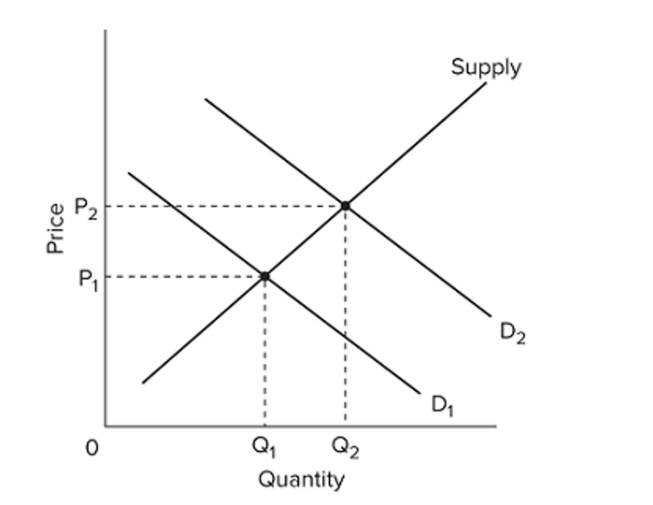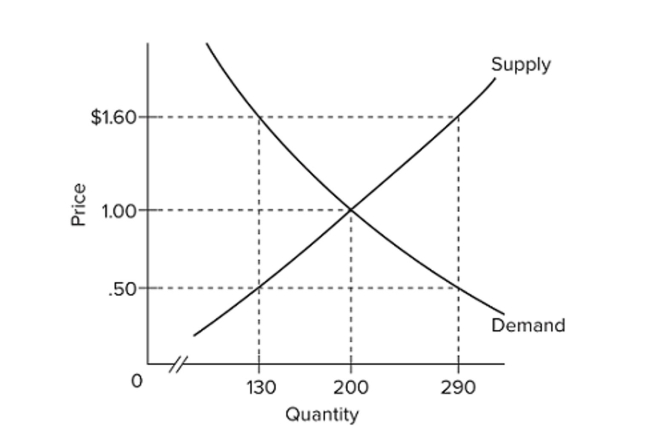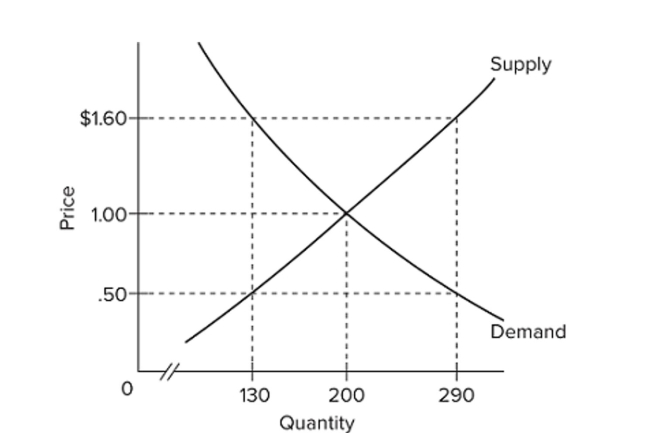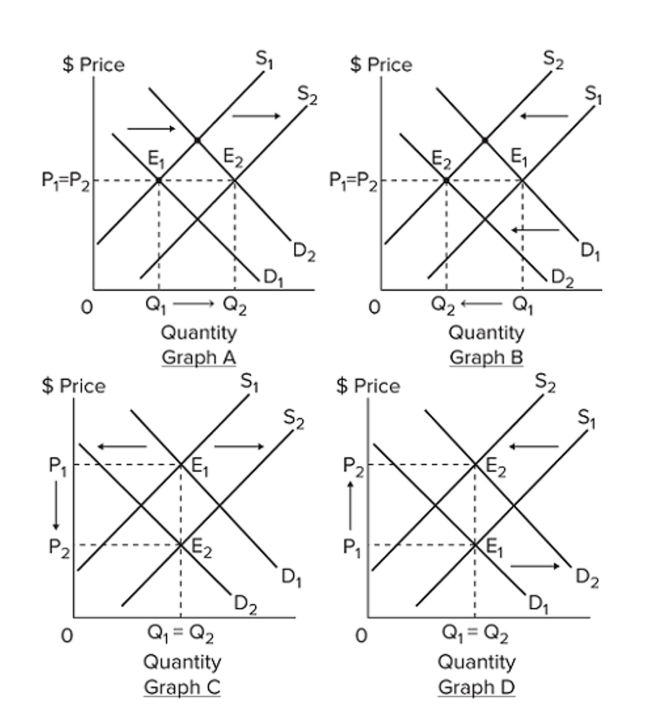A) A only
B) B only
C) C only
D) D only
Correct Answer

verified
Correct Answer
verified
True/False
Consumers buy more of normal goods as their incomes rise.
Correct Answer

verified
Correct Answer
verified
Multiple Choice
 Refer to the above graph showing the market for a product. Which of the following could not explain the indicated increase in equilibrium price from P1 to P2?
Refer to the above graph showing the market for a product. Which of the following could not explain the indicated increase in equilibrium price from P1 to P2?
A) an increase in consumer incomes
B) an increase in production costs
C) a decrease in the price of a complementary product
D) an increase in the price of a substitute product
Correct Answer

verified
Correct Answer
verified
Multiple Choice
 Refer to the diagram. A shortage of 160 units would be encountered if price was
Refer to the diagram. A shortage of 160 units would be encountered if price was
A) $1.10, that is, $1.60 minus $.50.
B) $1.60.
C) $1.00.
D) $0.50.
Correct Answer

verified
Correct Answer
verified
Multiple Choice
In competitive markets, a surplus or shortage will
A) never exist because the markets are always at equilibrium.
B) cause changes in the quantities demanded and supplied that tend to eliminate the surplus or shortage.
C) cause shifts in the demand and supply curves that tend to eliminate the surplus or shortage.
D) cause changes in the quantities demanded and supplied that tend to intensify the surplus or shortage.
Correct Answer

verified
Correct Answer
verified
Multiple Choice
In the following question you are asked to determine, other things equal, the effects of a given change in a determinant of demand or supply for product X upon (1) the demand (D) for, or supply (S) Of, X; (2) the equilibrium price (P) of X; and (3) the equilibrium quantity (Q) of X. A reduction in the number of firms producing X will
A) increase D, increase P, and increase Q.
B) increase S, decrease P, and increase Q.
C) decrease S, increase P, and decrease Q.
D) decrease S, decrease P, and increase Q.
Correct Answer

verified
Correct Answer
verified
Multiple Choice
 Refer to the diagram. A surplus of 160 units would be encountered if the price was
Refer to the diagram. A surplus of 160 units would be encountered if the price was
A) $1.10, that is, $1.60 minus $.50.
B) $1.60.
C) $1.00.
D) $0.50.
Correct Answer

verified
Correct Answer
verified
Multiple Choice
 Refer to the four graphs above. Select the graph that best shows the changes in demand and supply in the market specified in the following situation: the market for music CDs sold in stores, if
More consumers switch to music-downloads from the Internet and the cost of making music CDs
Decreases because of technological improvement in production.
Refer to the four graphs above. Select the graph that best shows the changes in demand and supply in the market specified in the following situation: the market for music CDs sold in stores, if
More consumers switch to music-downloads from the Internet and the cost of making music CDs
Decreases because of technological improvement in production.
A) Graph A
B) Graph B
C) Graph C
D) Graph D
Correct Answer

verified
Correct Answer
verified
Multiple Choice
In which of the following instances is the effect on equilibrium price (whether it rises, falls, or remains unchanged) dependent on the magnitude of the shifts in supply and demand?
A) demand rises and supply rises
B) supply falls and demand remains constant
C) demand rises and supply falls
D) supply rises and demand falls
Correct Answer

verified
Correct Answer
verified
Multiple Choice
75,
A) a smaller quantity of C will be demanded.
B) a larger quantity of C will be demanded.
C) the demand for C will increase.
D) the demand for C will decrease.
Correct Answer

verified
Correct Answer
verified
Multiple Choice
Increasing marginal cost of production explains
A) the law of demand.
B) the income effect.
C) why the supply curve is upsloping.
D) why the demand curve is downsloping.
Correct Answer

verified
Correct Answer
verified
Multiple Choice
A leftward shift of the supply curve for oil in the United States is most likely to result from
A) a decrease in the fees that oil companies must pay for drilling licenses.
B) an increase in the subsidy for oil exploration and drilling.
C) a decrease in the world price of oil.
D) an increase in the costs of exploration and drilling for oil.
Correct Answer

verified
Correct Answer
verified
Multiple Choice
(Advanced analysis) The demand for commodity X is represented by the equation P = 10 - 0.2Q and supply by the equation P = 2 + 0.2Q. If demand changes from P = 10 - 0.2Q to P = 7 - 0.3Q, we can Conclude that
A) demand has increased.
B) demand has decreased.
C) supply will increase.
D) supply will decrease.
Correct Answer

verified
Correct Answer
verified
Multiple Choice
If consumer incomes increase, the demand for product X
A) will necessarily remain unchanged.
B) may shift either to the right or left.
C) will necessarily shift to the right.
D) will necessarily shift to the left.
Correct Answer

verified
Correct Answer
verified
Multiple Choice
The relationship between quantity supplied and price is _____, and the relationship between quantity demanded and price is _____.
A) direct; inverse
B) inverse; direct
C) inverse; inverse
D) direct; direct
Correct Answer

verified
Correct Answer
verified
Multiple Choice
In this market, economists would call a government-set minimum price of $50 a
A) price ceiling.
B) price ?oor.
C) equilibrium price.
D) fair price.
Correct Answer

verified
Correct Answer
verified
Multiple Choice
Which of the following is most likely to be an inferior good?
A) smartwatches
B) ocean cruises
C) used clothing
D) steak
Correct Answer

verified
Correct Answer
verified
Multiple Choice
An effective price floor on wheat will
A) force otherwise profitable farmers out of business.
B) result in a shortage of wheat.
C) result in a surplus of wheat.
D) clear the market for wheat.
Correct Answer

verified
Correct Answer
verified
True/False
A ceiling price in a competitive market will result in persistent surpluses of a product.
Correct Answer

verified
Correct Answer
verified
Multiple Choice
If the supply and demand curves for a product both decrease, then equilibrium
A) quantity must fall and equilibrium price must rise.
B) price must fall, but equilibrium quantity may rise, fall, or remain unchanged.
C) quantity must decline, but equilibrium price may rise, fall, or remain unchanged.
D) quantity and equilibrium price must both decline.
Correct Answer

verified
Correct Answer
verified
Showing 201 - 220 of 357
Related Exams